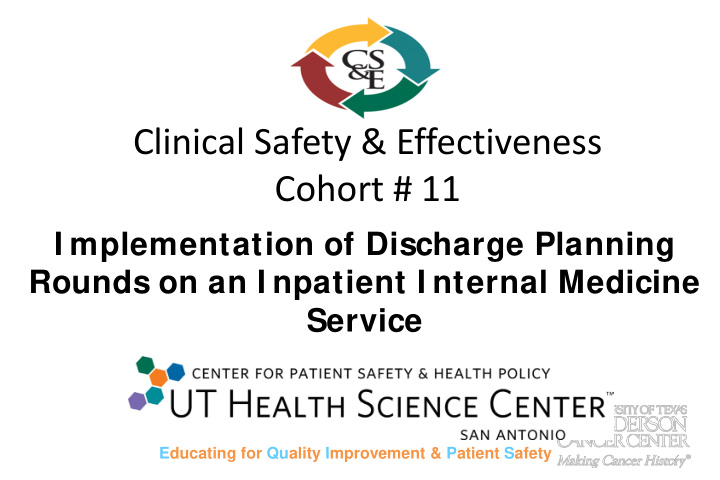



Clinical Safety & Effectiveness Cohort # 11 I mplementation of Discharge Planning Rounds on an I npatient I nternal Medicine Service DATE Educating for Quality Improvement & Patient Safety 1
Financial Disclosure Raj Sehgal, MD has no relevant financial relationships with commercial interests to disclose. 2
The Team Raj Sehgal, MD (CS&E participant) Amjed Baghdadi, Chief of Quality Management, STVHCS Vivian Dee, Hospital Medicine Nurse Practitioner Utilization Management RNs: Kelli Alexander, Erica Barrett Mary Gaona, Marilyn Ponce, Elaine Wolff Social Workers: Angela Bodnar, Ileana Elizardo, Elizabeth Lopez, Catherine Rivera, Lynda Sandoval, Donna Stribling Sponsor Department Luci Leykum, MD, MBA, MSc Division Chief, Hospital Medicine, UTHSCSA Deborah Baruch-Bienen, MD, MA Ethics, FACP Chief, Medicine Service, STVHCS AMD 3
What We Are Trying to Accomplish? OUR AIM STATEMENT Increase by 5% patients meeting criteria for continued stay on internal medicine inpatient ward teams by August 2012. 4
Project Milestones • Team Created April 2012 • AIM statement created April 15, 2012 • Weekly Team Meetings Started May 2012 • Background Data, Brainstorm Sessions, Started May 2012 Workflow and Fishbone Analyses 1 st : May 14 • Interventions Implemented 2 nd : June June 4 • Data Analysis Started July 2012 • CS&E Presentation September 14, 2012 5
Background • One of the benefits of the VA system is the availability of additional resources for many patients post-hospitalization (home health, skilled nursing facilities, hospice, etc.) • One of the frustrations (particularly for trainees) is navigating this process and getting patients discharged from the acute care setting in an appropriate time frame • Patients in the hospital without a clear indication are at risk for hospital-related complications (infections, deconditioning, etc.) and occupy beds needed for other acutely ill patients • Utilization management nurses review inpatients each day to determine if patients continue to meet criteria for continued hospitalization 6
Background Patients Meeting Continued Stay Criteria 75.0% UCL 71.6% 70.0% 65.0% % of Patients 60.0% CL 56.7% 55.0% 50.0% 45.0% LCL 41.8% 40.0% 35.0% Mar-11 May-11 Jul-11 Sep-11 Nov-11 Jan-12 Mar-12 May-12 Month Average: 57% 7
Background Administrative View Clinician View No Medical Needs Not Meeting Criteria Medical Needs, Delays in Care Medical Needs, Meeting Criteria Timely Care 8
How Will We Know That a Change is an Improvement? • Types of measures – % of patients meeting criteria for continued hospitalization on the inpatient internal medicine service (using McKesson InterQual Level of Care Criteria) • Methods of measurement – Summative monthly reports from Quality Management service based on daily patient reviews • Specific targets for change – Original: 5% increase in the percentage of patients meeting inpatient criteria for continued stay on internal medicine ward teams from May to August 2012. – Revised: Raising percentage of patients meeting inpatient criteria to 64% 9
Plan – Do – Check - Act Discharge planning process (as of April 2012) 10
11
Plan – Do – Check - Act 12
Plan – Do – Check - Act Patients Meeting Continued Stay Criteria (Medicine Ward Teams) 97% 89.01% 87% 77% UCL 71.63% 70.02% % of Patients 67% CL 56.71% 57% 51.02% 47% LCL 41.79% 37% Mar-11 May-11 Jul-11 Sep-11 Nov-11 Jan-12 Mar-12 May-12 Jun-12 Aug-12 Month 13
Patients Meeting Continued Stay Criteria - Neurology 70.00% UCL 65.57% 65.00% 60.00% % of Patients 55.00% CL 52.57% 50.00% 45.00% LCL 39.57% 40.00% 35.00% Apr-12 May-12 Jun-12 Jul-12 Month Patients Meeting Continued Stay Criteria - Cardiology 100.00% UCL 89.84% 90.00% % of Patients 80.00% 70.00% CL 60.01% 60.00% 50.00% 40.00% LCL 30.18% 30.00% 20.00% Apr-12 May-12 Jun-12 Jul-12 Month 14
Plan – Do – Check - Act 1. Continue daily discharge planning rounds on the Medicine Ward service with all VA hospitalists trained to perform PUMA (Physician Utilization Management Advisor) duties. 2. Consider spreading process to other inpatient services. 15
Return on Investment Medicine Ward Teams % of patients meeting continued stay criteria: Previous Quarter (Q2) without intervention: 52.5% Intervention Period: 70.0% Medicine Service (including neurology, cardiology, BMT, MICU) % of patients meeting continued stay criteria: Previous Quarter (Q2) without intervention: 51.2% Intervention Period: 73.8% 16
Return on Investment 17
Return on Investment 18
Conclusion/What’s Next Lessons Learned • Relatively small investments can have major impacts on patient care • Time required of attending physicians & social workers: 5 minutes, 5 days a week • Time required of UM nurses and Medicine Case Manager NP: 20-30 minutes daily, 5 days a week • Communication is key What’s Next • Find ways to collect (and use) the data on processes that delay patients’ care in the hospital. • Check re-admission data 19
Thank you! Educating for Quality Improvement & Patient Safety 20
Recommend
More recommend